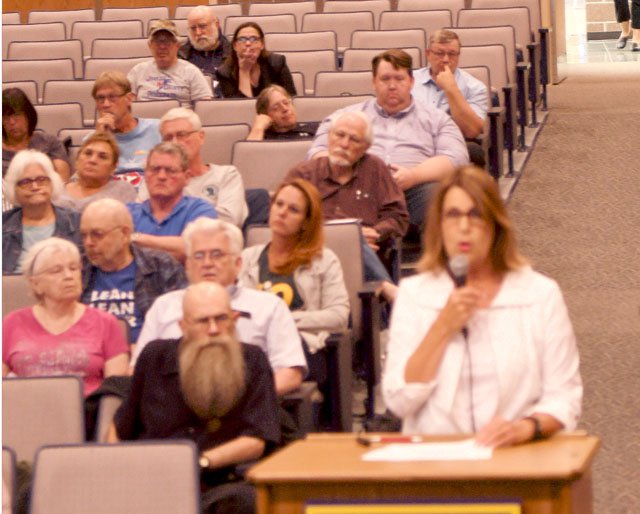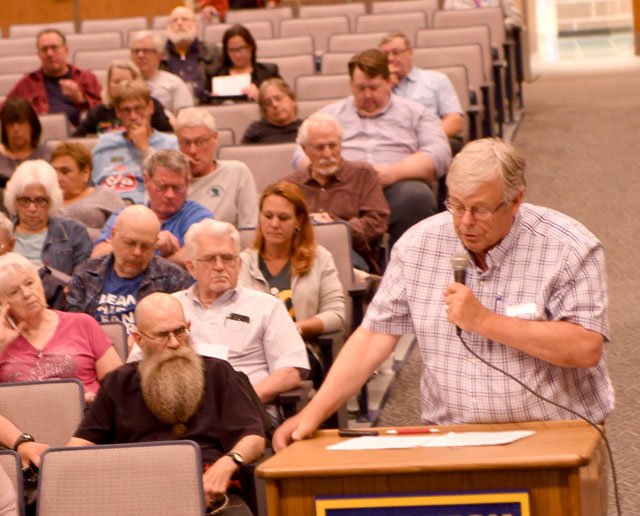SOUTHWEST WISCONSIN - Two hearings of the Wisconsin State Assembly Speaker’s Task Force on Water Quality held recently in Mauston and LaCrosse continue to illustrate the state’s water woes.
The variety of hydrogeology and soils in different regions of the state mean that the challenges facing residents will also vary.
At the Lancaster hearing, held in early May, the karst geology of Grant, Iowa and Lafayette counties, and the results of the well water testing in the Southwest Wisconsin Groundwater and Geology (SWIGG) study was a major focus of the discussion.To read about the Lancaster hearing, go to: https://www.independentscout.com/local/speakers-water-quality-task-force-holds-first-meeting-in-lancaster/
Like those counties, Crawford, Vernon and Richland are challenged with a sensitive karst landscape. In Mauston, as in parts of LaCrosse County, the challenges pertain to a shallow sandy layer of soil over a shallow aquifer.
The common theme was that excess nutrients and chemicals are entering the state’s surface and ground water, and pose significant health risks. Most concerns revolve around elevated levels of nitrate and bacteria in ground water, and phosphorous in surface waters. Although nitrate can come from human waste, it also comes from animal waste and agricultural fertilizers. There was also discussion of the increasing incidence of groundwater contamination with PFAs (per-and-polyfluoroalkyl substances) that are used in airport fire fighting. Wells in Madison and LaCrosse have been found to be contaminated with these compounds and shut down.
Nitrate pollution
Similar to the issues facing Holmen and Onalaksa townships in LaCrosse County, water quality problems in Juneau, Wood, and Adams counties relate to sandy soils overlaying a shallow, unconfined aquifer. This kind of hydrogeology is very vulnerable to groundwater contamination.
Also similar to the situation in LaCrosse County, problems with dangerously elevated nitrate levels in private wells can likely be traced, at least in part, back to a confined animal feeding operation (CAFO) in the area where wells are contaminated. In LaCrosse County it is the swine CAFO, Babcock Genetics. In Juneau County, it is the Central Sands Dairy.
Nancy Eggleston with the Wood County Health Department, has been on the front lines in dealing with nitrate contamination of drinking water in Wood, Juneau and Adams counties. Her department has a water testing lab that has been used to conduct a groundwater study in the three counties.

The controversy over dangerous levels of nitrate pollution in private wells was sparked by a Wood County mother’s anguished blog post about the death of her infant. Celina Stewart, a young mother in the town of Nekoosa, lost an infant daughter to a fatal brain malformation that has been associated with high levels of nitrate found in drinking water. Nitrate levels in the family’s well were measured at 42 parts-per-million (ppm). The federal drinking water standard for nitrates is 10 ppm.
In response, a hundred angry neighbors with undrinkable water met to consider suing one of the biggest agricultural businesses in the state.
The tragedy led to a community well testing program in Armenia and Port Edwards this year, which found that 40 percent of the homes had nitrate concentrations that, like Stewart’s, were far above the legal limit.
It also led to a lawsuit filed by 81 residents, and to the EPA becoming involved. The EPA drilled 41 monitoring wells around the 3,000-animal-unit dairy. Testing revealed that 41 percent of the shallower monitoring wells exceed the federal drinking water standard for nitrate, and 42 percent of the deeper wells exceeded the standard.
In two rounds of testing in Wood County, 20 percent and 24 percent of wells sampled were found to have unsafe levels of nitrates. In Juneau County, 41 percent and 18 percent of wells sampled had unsafe nitrate levels – an overall result of 31 percent of sampled wells being unsafe to drink.
Ultimately, an agreement was reached between an association of three farms known as the Armenia Growers Coalition (AGC), the EPA, the DNR, and county corporate counsels and Health Departments about how to proceed with remediation.
According to Eggleston, a voluntary memorandum of understanding was crafted with four objectives:
• Identify where there is potable water for residents
• Guarantee that the water will remain potable for at least 25 years
• Recommend needed well casing depths
• Recommend changes in land use
Eggleston summed up progress on initiatives called for in the memorandum of understanding.
“Seven reverse osmosis systems have been installed, and 14 more are scheduled. Bottled water has been made available. 104 homes were tested in May of 2018, and 432 homes in April/May of 2019, leaving 464 more to test in the area. The DNR is working with AGC to initiate the groundwater study, and the farmer-led initiative to evaluate impacts of agricultural land use on water quality has not yet begun.”
Wisconsin State Senator Patrick Testin told Eggleston that the Joint Finance Committee had approved a program within the Wisconsin Department of Health Services which allows residents to receive a grant of up to $2,500 for remediation. He asked if she would encourage her county to enroll in the program.
“Yes,” Eggleston answered, “if it also focuses on identifying and remediating the source of the problem.”
In LaCrosse County, unsafe levels of nitrate pollution in private wells in Holmen and Onalaska townships were discovered in 2017. Since then, the county formed a Nitrate Task Force, and there has been a water-testing program and a public outreach campaign encouraging well owners to test their water. The Wisconsin Pollutant Discharge and Elimination System (WPDES) permit for Babcock Genetics was recently renewed, despite citizen opposition. Nitrate contamination is especially dangerous for pregnant women and babies, and has been tied to ‘Blue Baby Syndrome.’
“Our focus has been on testing wells in the target area and helping well owners to troubleshoot remediation,” LaCrosse County Health and Lab Manager Carol Drury told the Task Force. “In addition, we’ve implemented a multi-media outreach and education campaign, and we’ve received a grant from the CDC that has allowed us to expand our testing to include arsenic and lead.”
At the LaCrosse hearing, Midwest Environmental Advocates Executive Director Kimberlee Wright pointed out that a study had just come out that day linking nitrate pollution in drinking water to development of certain kinds of cancers, in particular bladder cancer. So, the problems seem to go beyond pregnant women and babies.
Nutrient management
Management of nutrients from agriculture and industry was a big topic at both of the recent hearings.
In Mauston, representatives of the Wisconsin Association of Professional Agricultural Consultants (WAPAC) talked about the ways their industries work to keep nutrients such as nitrate and phosphorous out of the water through manure pit siting and nutrient management plans.
State Representative Travis Tranel asked the WAPAC representatives what the legislature could do to make nutrient management plans more farmer-friendly, and transform their perception from a ‘requirement’ to a ‘benefit?’
“For smaller farmers, we offer a simpler version of the plan,” the WAPAC representative said. “But when a smaller farmer tries to work on it themselves, it can be very confusing – what is essential is to perform individual consultations with both farmers and their manure haulers.”
State Representative Katrina Shankland reported that at this year’s Land and Water state convention, there had been a unanimous vote to include hydrologic considerations in the SNAP Plus nutrient management computer program. She said that it has been well documented that SNAP Plus pre-sets are geared to guide farmers towards maximum nitrogen application.
Duke Welter of the Trout Unlimited Driftless Area Restoration Effort told the task force at the Mauston hearing that his number one message to the task force members was that they must act to protect the health of Wisconsin citizens by protecting groundwater.

“Back in 2006 when I sat on the Natural Resources Board, we were grappling with kids from Kewaunee County having to go to the hospital for health problems associated with bacteria and nitrate contamination of their drinking water, and I’m not sure how much progress we’ve really made,” Welter said. “We shouldn’t be discussing how much pollution is acceptable.”
Welter identified two things the legislature could do – conduct more surface and groundwater testing, and increase oversight of CAFOs, manure management and nutrient management.
“In Vernon County, we’ve just had the second manure spill in less than two years from the Wild Rose Dairy,” Welter said. “This year, in Wisconsin, we are on pace for 100 manure spills, and you must give the DNR more staffing and resources to do this important work.”
In the public comment section of the agenda, citizens at both hearings spoke about nutrient management.
Chris Zindorf of the Juneau County Board of Supervisors spoke about how Wisconsin had experienced “eight years of state-sponsored neglect,” with reduction of DNR staff and no enforcement of the CAFOs.
“We need to amend the NR 151 manure management rule to fit the different types of soils and geology we have around the state,” Zindorf said. “Our county has spent $35,000 in response to the crisis in Armenia and Port Edwards due to the state failing to act. We need the state to reimburse us the $35,000, and we need you to allocate more money to help us fix this problem.”
Ryan Knudson of Port Edwards said, “Nitrates have been climbing exponentially in groundwater over the last decade, and nutrient management plans must emphasize the safety of groundwater and you must restore clout to the DNR.”
Kristie Greening, who attended both the Mauston and LaCrosse hearing weighed in on the topic of nutrient management plans.
“I’ve been in meetings where DNR and DATCP staff admit that nutrient management plans were never intended to be used on facilities the size of CAFOs,” Greening said. “DNR and DATCP staff also admit that their standards for CAFOs don’t match, and even though the Livestock Facility Siting law has to be reviewed every four years, it has not been updated for the last 12 years.”
Representative Shankland observed that both Portage and Trempealeau counties have passed resolutions asking for a repeal of the Livestock Facility Siting Law.
Jason Fuller of Carbon Cycle Consulting LLC spoke to the task force at the LaCrosse hearing about innovations with composting manure as an alternative to manure lagoons and land spreading of liquid manure.
“Composting of manure is a method of aeroblic decomposition that basically mimics nature,” Fuller explained. “It is an opportunity for dairy producers, but also to stimulate a private sector fertilizer business.”
Fuller said that in addition to composting manure, his model can also accept waste from grass clippings, paper mills waste, and more, to add into the compost made from manure. He said that the cost to produce a ton of compost is about $150, and the value is about $200 a ton. He said that composted dairy manure will have a N-P-K ratio of 1:1:1.
Look for the second part of this story in next week’s issue where the testimony regarding phosphorous pollution, water quantity issues, PFAs contamination, and need for additional funding is discussed.




